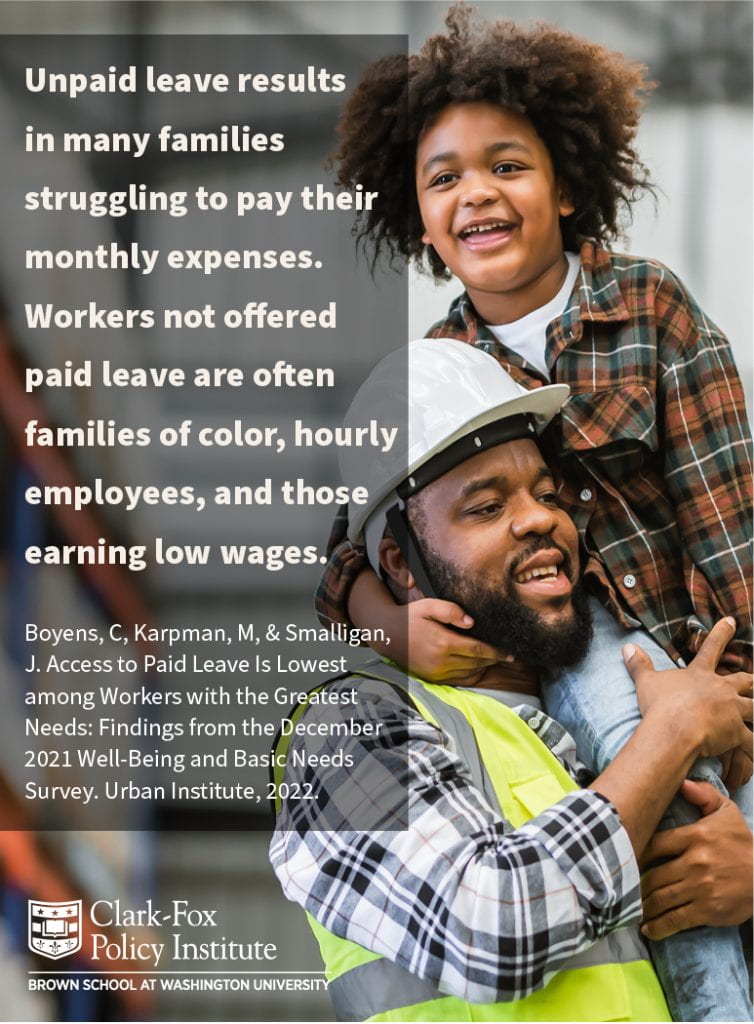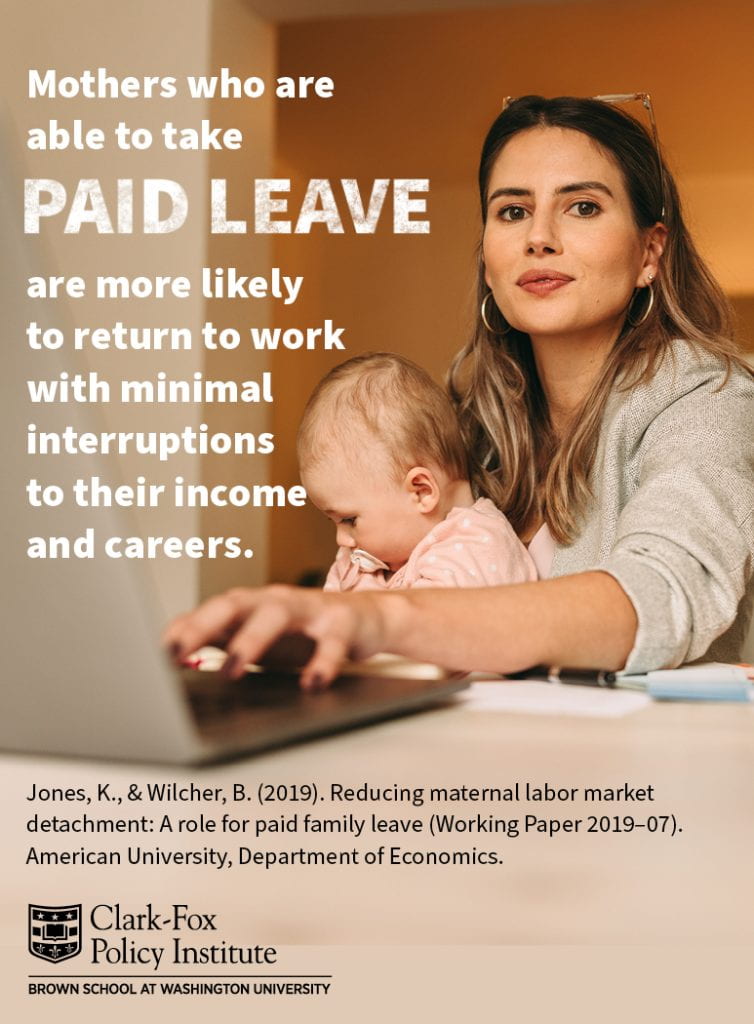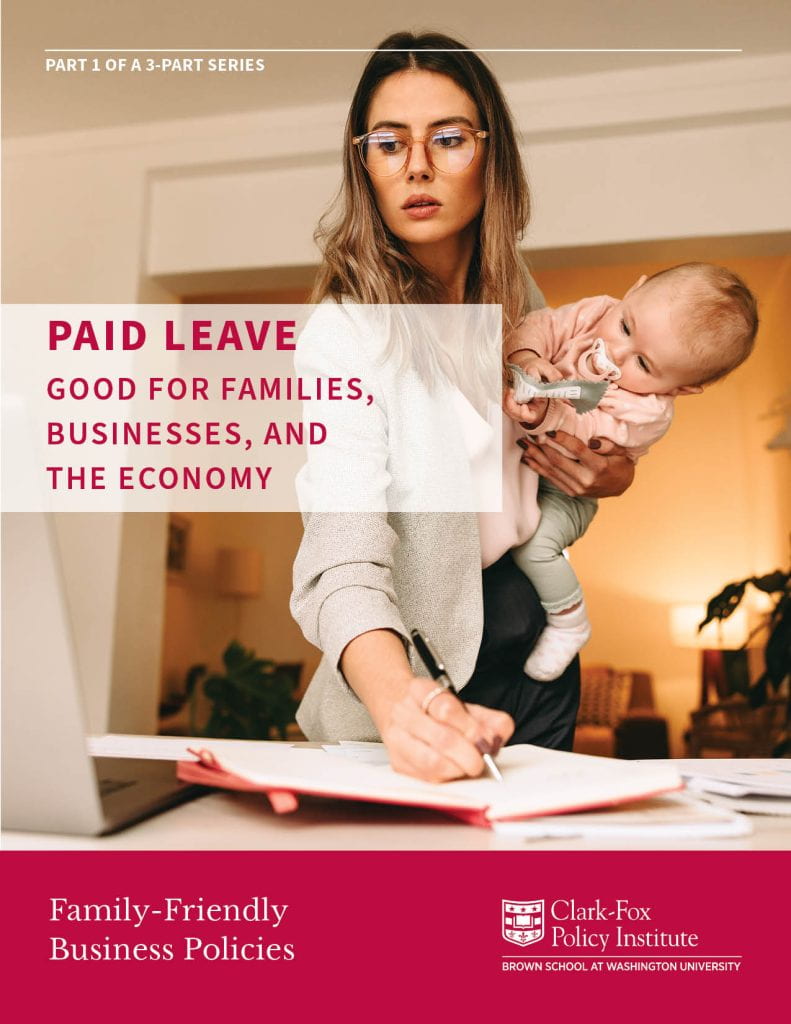Family-Friendly Business Policies
Part 1 of a 3-Part Series
The Clark-Fox Policy Institute has produced a three-part policy brief focused on family-friendly business policies
The evidence-informed policy recommendations were developed by layering scientific research with community voice. They are aimed at supporting employees by providing the flexibility needed to balance the responsibilities of work and family while financially supporting their families. Businesses in any sector benefit by retaining valuable talent and empowering employees to be undistracted and productive at work. The evidence-informed policy recommendations are human-centered, help maintain a healthy and sustainable workforce, and support a growing and thriving economy.
Part one in this three-part series makes the case for paid leave, which is defined as a portfolio of benefits that are offered to employees to protect their income when they need to take a limited period of time off from work to care for themselves or a family member.
The Benefit of Implementing Paid Leave

COVID-19 caused unprecedented rates of unemployment.1 Now, as infection and mortality rates are on the decline, businesses are reopening and experiencing labor shortages that are slowing the economic recovery.2 One-third of working adults report having to choose between career advancement and attending to their family’s needs.3 Long working hours, low wages, and limited access to paid leave contribute to a diminished workforce, leaving businesses unable to meet demands for goods and services.
Thirteen states (California, Colorado, Connecticut, Delaware, Maine, Maryland, Massachusetts,
Minnesota, New Jersey, New York, Oregon, Rhode Island, Washington) and Washington, D.C., have passed legislation requiring some form of paid leave to be offered to employees. The structure and implementation vary from state to state. Some paid leave is funded solely by businesses, some by employees, and some by a combination of both.4
Businesses can establish family-friendly policies on their own. There is no need to wait for federal or state mandates to implement paid leave. Businesses looking to attract and retain qualified workers should offer paid leave.
Large businesses like Amazon, Netflix, and Microsoft have moved forward with offering robust paid leave to their employees as a strategy to compete for the best talent.5 Yet in 2023, the Department of Labor reported that just 27% of workers had access to paid family leave.6 According to a study conducted by Small Business Majority and the Center for American Progress, 70% of small businesses believe in offering paid leave to their employees and support the creation of a federal program that will guarantee access to paid leave.7
Providing paid leave can improve the health and well-being of children and their parents, and
ultimately, reduce costs of high turnover and employee dissatisfaction.8-11 When employees choose to leave work to care for family, turnover costs for businesses average around 20% of the employee’s annual salary.12 For example, replacing an employee who makes $50,000 a year will likely cost a business $10,000 in replacement costs.
“Parents shouldn’t have to choose between their careers and family responsibilities. By adopting paid leave policies, businesses can directly support working families and drive economic growth.”
Gary Parker, PhD
Paid Leave: Medical Care for Family
More than 40% of employees report having no paid leave—not even one day—to care for a sick family member.13 The Family and Medical Leave Act (FMLA), signed into law in 1993 by President Bill Clinton, allows employees to take 12 weeks of unpaid leave without being penalized to care for medical and family emergencies or a new child. When employees consider using FMLA, they must determine if they are able to forgo pay during that time.
Unfortunately, unpaid leave results in many families struggling to pay their monthly expenses. Families lose an estimated $22.5 billion in wages each year due to a lack of paid family and medical leave.14 Workers not offered paid leave are often families of color, hourly employees, and those earning low wages.15

Paid Leave: Parental Care for New Child
Parents have to make many difficult decisions when planning for a new child. Most will need to determine if they can afford to take unpaid leave. Without paid leave, families are faced with few options for making ends meet after the arrival of a new child. Some businesses allow new parents to use their existing sick or vacation days. Others offer short-term disability leave.

While some parents may have access to these options, most do not.16 Among the lowest-wage workers, who are primarily women of color, 94% have no access to paid family leave.13 This leaves many new parents with the choice of either taking unpaid leave or quitting their job.
Offering paid leave following the birth or adoption of a new child helps parents stay in the workforce. Mothers who can take paid leave are more likely to return to work with fewer interruptions to their income and careers.17 Paid family leave can decrease moms leaving the workforce by nearly 20%.17 More moms in the workforce would not only help reduce labor shortages, it would fuel economic growth.1
Paid leave is also directly linked to employees’ positive physical and mental health. Paid leave improves parent and child well-being by:19,20
- Decreased rates of postpartum depression.
- Improved physical health of mothers and children.
- Decreasing risk of infant death or rehospitalization of mothers.
- Giving more time for bonding, which is crucial for brain development starting in the womb and running through the first year of life.
Just like mothers, fathers need access to paid leave. Parental leave gives new dads time to bond with their children and increases their involvement in childcare responsibilities months after their leave ends.21,22 Children with more engaged fathers have better health and development.23,24
Unfortunately, even when fathers are offered parental leave, they are far less likely to take the time. Some fathers feel that they will be viewed as less committed to the workplace and have reported experiencing the stigma of being labeled as inflexible, leading them to choose to cut their parental leave short.25
Nearly 70% of Americans believe dads should have access to new parent leave.26 Regardless of gender, paid leave benefits families and should be accessible and adequate for people who need to take care of themselves and their family.
Paid Leave Policies
A larger, more productive workforce is critical to economic recovery in the wake of the COVID-19 pandemic. Creating a supportive work environment that respects the work-life balance of working parents will help businesses attract and retain the best talent. Paid leave is good for businesses and families. Paid leave enhances the lives of parents and their children, offers sustainability for businesses, and grows the economy.27
To ensure that all employees — including hourly and low-wage workers — can benefit from family-friendly policies, legislation should be passed to create nationwide publicly funded programs for paid leave. Businesses that are able do not need to wait for federal or state mandates. They can immediately implement paid leave. Public subsidies could help small businesses, such as those with 1-50 full‑time employees, also offer paid leave to their employees.
Evidence-informed policy recommendations

Provide at least eight weeks of paid leave to care for
- an employee’s own health
- a new child
- existing children
- a foster child
- spouses
- other family members

Guarantee job and income protection when the employee returns from leave.

Use gender-neutral language to include diverse families, parents, and caregivers who identify across the gender spectrum.

Allow all employees to be eligible immediately for at least two weeks paid leave with the benefit increasing over time of employment.

Intentionally create a culture where fathers and same-sex families are encouraged to take paid leave to care for a new child.
Note:
Although this brief refers to the need for mothers and fathers to have access to paid leave, we are aware and want to be inclusive of people who do not identify as either gender. Access to paid leave benefits all parents regardless of gender. The binary construct of gender is used only when referring to previously conducted research.
Special thanks to the Gateway Early Childhood Alliance for hosting a community listening session with working parents. This provided the institute with stories and insights from families that would benefit from paid leave.
The Clark-Fox Policy Institute
The Clark-Fox Policy Institute is dedicated to child well-being through the development and dissemination of evidence-informed policy. Building on the foundation of scientific research, the institute layers empirical data with the lived experience of the impacted population. Science alone cannot drive the policymaking process, and the institute is committed to working with communities whose voices are often left unheard. To achieve this, the institute serves as a regional convener and a catalyst for addressing pressing social issues.
Suggested citation:
Strombom, N., Thurman, A., Poole, S., Andersen, S., and Parker, G. (2024). Paid Leave: Good for Families, Businesses, and the Economy. Family-Friendly Business Policies. St. Louis, MO: The Clark-Fox Policy Institute, Brown School at Washington University in St. Louis.
Contact info
Clark-Fox Policy Institute
Gary Parker, PhD, Director
Brown School at Washington University in St. Louis
1 Brookings Drive, MSC 1196-251-46
St. Louis, MO 63130
314-935-8807
gary.parker@wustl.edu
clarkfoxpolicyinstitute.wustl.edu
References
- Monthly labor review. Unemployment rises in 2020, as the country battles the COVID-19 pandemic. (2023, June). U.S. Bureau of Labor Statistics. https://www.bls.gov/opub/mlr/2021/article/unemployment-rises-in-2020-as-the-country-battles-the-covid-19-pandemic.htm
- Ferguson, S. (2023, November 20). Understanding America’s labor shortage. U.S. Chamber of Commerce. https://www.uschamber.com/workforce/understanding-americas-labor-shortage
- Raising kids and running a household: How working parents share the load. (2015, November 4). Pew Research Center. https://www.pewresearch.org/social-trends/2015/11/04/raising-kids-and-running-a-household-how-working-parents-share-the-load
- Paid family leave. (n.d.). Prenatal-to-3 Policy Impact Center. Retrieved December 1, 2023, from https://pn3policy.org/pn-3-state-policy-roadmap-2023/us/paid-family-leave/
- McGee, S. (2016, March 13). Growing momentum to expand paid leave is fantastic news for Americans. The Guardian. https://www.theguardian.com/money/us-money-blog/2016/mar/13/ paid-leave-benefits-vermont-minnesota-congress-obama
- U.S. Bureau of Labor Statistics. (2023, September 21). Employee benefits. https://www.bls.gov/ebs/ factsheets/family-leave-benefits-fact-sheet.htm
- Small Business Majority. Small businesses support paid family leave programs. (2018, November 14). https://smallbusinessmajority.org/our-research/workforce/small-businesses-support-paidfamily-leave-programs
- Bartel, A., Rossin-Slater, M., Ruhm, C., Slopen, M., & Waldfogel, J. (2023). The impacts of paid family and medical leave on worker health, family well-being, and employer outcomes. Annual Review of Public Health, 44, 29–43. https://www.annualreviews.org/doi/10.1146/annurevpublhealth-071521-025257
- Bullinger, L. R. (2019). The effect of paid family leave on infant and parental health in the United States. Journal of Health Economics, 66, 101–116. https://doi.org/10.1016/j.jhealeco.2019.05.006
- Bedard, K., & Rossin-Slater, M. (2016). The economic and social impacts of paid family leave in California: Report for the California Employment Development Department [technical report]. https://edd.ca.gov/siteassets/files/disability/pdf/PFL_economic_and_social_impact_study.pdf
- Bartel, A., Rossin-Slater, M., Ruhm, C., Slopen, M., & Waldfogel, J. (2023). The impact of paid family leave on employers: Evidence from New York. Community, Work & Family, 0(0), 1–19. https://www.nber.org/papers/w28672
- Boushey, H. & Glynn, S. J. (2012, November 16). There are significant business costs to replacing employees. Center for American Progress. https://www.americanprogress.org/article/there-aresignificant-business-costs-to-replacing-employees/
- Women’s Bureau. Paid family and medical leave fact sheet. U.S. Department of Labor. https://www.bls.gov/ebs/factsheets/family-leave-benefits-fact-sheet.htm
- Center for American Progress. (2020, January 21). The rising cost of inaction on work-family policies. https://www.americanprogress.org/article/rising-cost-inaction-work-family-policies/
- Boyens, C, Karpman, M, & Smalligan, J. Access to paid leave Is Lowest among workers with the greatest needs: Findings from the December 2021 Well-Being and Basic Needs Survey. Urban Institute, 2022. https://www.urban.org/research/publication/access-paid-leave-lowest-among-workers-greatest-needs
- Ranji, U., Long, M., Frederiksen, B., Diep, K., & Published, A. S. (2022). Workplace benefits and family health care responsibilities: Key findings from the 2022 KFF Women’s Health Survey. Kaiser Family Foundation. https://www.kff.org/womens-health-policy/issue-brief/workplace-benefits-and-family-health-care-responsibilities-key-findings-from-the-2022-kff-womens-health-survey/#:~:text=Key%20Takeaways,ill%20family%20member%20(44%25)
- Jones, K., & Wilcher, B. (2019). Reducing maternal labor market detachment: A role for paid family leave (Working Paper 2019–07). American University, Department of Economics. https://econpapers.repec.org/paper/amuwpaper/2019-07.htm
- Glynn, S.J.. (November 2023). The cost of doing nothing, 2023 update: The price we STILL pay without policies to support working families. Women’s Bureau, U.S. Department of Labor. https://www.dol.gov/sites/dolgov/files/WB/paid-leave/CostofDoingNothing2023.pdf
- Weber, A., Harrison, T. M., Steward, D., & Ludington-Hoe, S. (2018). Paid family leave to enhance the health outcomes of preterm infants. Policy, Politics & Nursing Practice, 19(1–2), 11–28. https://doi. org/10.1177/1527154418791821
- Prenatal-to-3 Policy Impact Center. (2023). Prenatal-to-3 policy clearinghouse evidence review: Paid family leave (ER 03D.0923). Peabody College of Education and Human Development, Vanderbilt University. https://pn3policy.org/policy-clearinghouse/paid-family-leave
- Nepomnyaschy, L., & Waldfogel, J. (2007). Paternity leave and fathers’ involvement with their young children. Community, Work and Family, 10(4), 427–453. https://doi.org/10.1080/13668800701575077
- Petts, R. J. & Knoester, C. (2018). Paternity leave-taking and father engagement. Journal of Marriage and Family, 80(5), 1144–1162. https://doi.org/10.1111/jomf.12494
- Huerta, M. del C., Adema, W., Baxter, J., Han, W.-J., Lausten, M., Lee, R., & Waldfogel, J. (2013). Fathers’ leave, fathers’ involvement and child development: Are they related? Evidence from four OECD countries. Organisation for Economic Co-operation and Development. https://doi.org/10.1787/5k4dlw9w6czq-en
- Sarkadi, A., Kristiansson, R., Oberklaid, F., & Bremberg, S. (2008). Fathers’ involvement and children’s developmental outcomes: A systematic review of longitudinal studies. Acta Paediatrica, 97(2), 153–158. https://doi.org/10.1111/j.1651-2227.2007.00572.x
- Vandello, J., Hettinger, V., Bosson, J., & Siddiqi, J. (2013). When equal isn’t really equal: The masculine dilemma of seeking work flexibility. Journal of Social Issues, 69, 303–321. https://doi.org/10.1111/josi.12016
- Horowitz, J. M., Parker, K., Graf, N., & Livingston, G. (2017, March 23). Americans widely support paid family and medical leave, but differ over specific policies. Pew Research Center’s Social & Demographic Trends Project. https://www.pewresearch.org/social-trends/2017/03/23/americanswidely-support-paid-family-and-medical-leave-but-differ-over-specific-policies/
- Joint Economic Committee. (n.d.). The economic benefits of paid leave: Fact sheet. Retrieved April 19, 2022, from https://www.jec.senate.gov/public/_cache/files/646d2340-dcd4-4614-ada9-be5b1c3f445c/jec-fact-sheet—economic-benefits-of-paid-leave.pdf
Part 3 of 3: The Next Generation: Preparing for the Future of the Workforce
